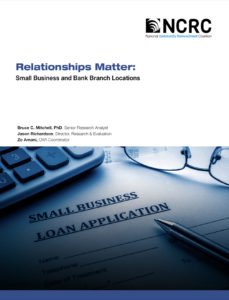 Relationships Matter: Small Business and Bank Branch Locations
Relationships Matter: Small Business and Bank Branch Locations
National Community Reinvestment Coalition
First published March 2021
The National Community Reinvestment Coalition (NCRC) analyzed the relationship between large banks that make small business loans and the number of branches those banks operate in each county in the United States. We found that the number of bank branches belonging to large banks and the gross domestic product (GDP) of a county are the two most important factors in the amount of small business lending in that county. Each year,
a single branch location generated small business lending of nearly $3.03 million in metro areas, $2.3 million in smaller cities and $1.9 million in rural areas after accounting for
other economic factors in our models. We also observed that between 2012 and 2018
the small business lending market has been increasingly dominated by the largest lending institutions. While bank branches across the country have continued their decline from peak levels in 2009, branch closures are less likely in communities where large banks make small business loans. Unfortunately, the lack of data from small and intermediate banks with asset sizes up to around $1.25 billion makes it difficult to assess the extent of their small business lending. This makes it critically important to implement marketwide small business loan transparency requirements under Section 1071 of the Dodd-Frank Act. We know
that the number of small banks in operation declined dramatically during the study period, likely reducing an important source of small business lending. This may mean that among banks that make small business loans the market is going to be dominated by larger banks, with consequences for smaller businesses that may find building a relationship with large banks difficult.
